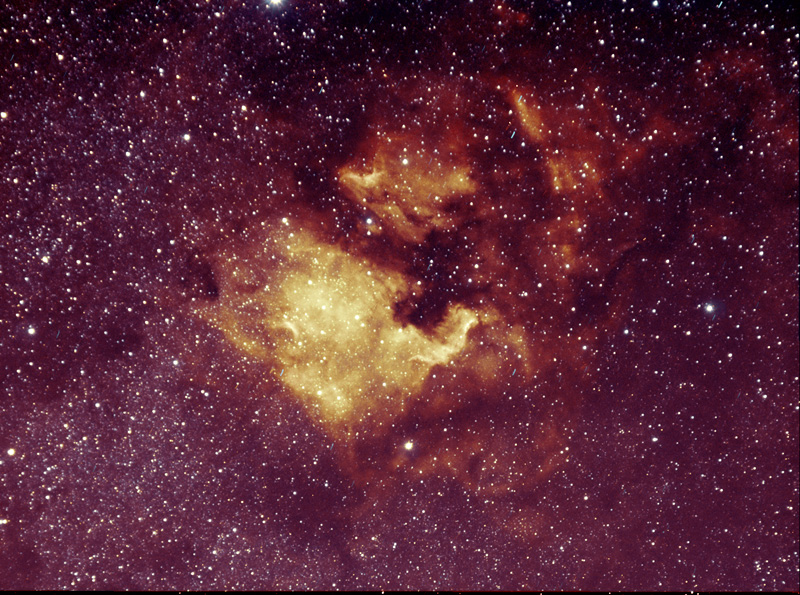

Image Centered on Ra.20 : 58.8 (h:m) Dec +44 : 20 (deg:m)
NGC 7000
Diffuse Nebula NGC 7000 (= H V.37 ?) in Cygnus
North America Nebula
Information (From the SEDS website)
Perhaps discovered by William Herschel on
October 24, 1786. Discovered by John Herschel before 1833.
This nebula is lying 3 degrees from bright Deneb, Alpha Cygni. Some people claim
it may be visible to the naked eye under good, dark conditions, and a preferred
object for amateur astrophotographers. The distance to the North America Nebula
is estimated at 1,600 light years. The North America Nebula was perhaps detected
by William Herschel who cataloged a "faint, extremely large, diffuse nebulosity"
near its place under his catalog number H V.37. John Herschel definitely found
it and cataloged it as h 2096 and later as GC 4621. It was first photographed by
Max Wolf on December 12, 1890.
In the North America Nebula, stars are forming. Three expressed open clusters in
the NGC catalog are probably associated with it:
In the north-western part of the North America Nebula, NGC 6989 has been
detected by William Herschel (H VIII.82, GC 4613) on September 11, 1790.
In its northern part, young open cluster NGC 6996 has formed; this cluster has
been discovered by John Herschel (h 2094, GC 4619) before 1833.
Stars west of the nebula (beyond its "East Coast") form young open cluster NGC
6997 which was found by William Herschel (H VIII.58, GC 4629) on October 24,
1786 (the same day he probably found the nebula), which have probably formed
from the same interstellar cloud.
Optics - Exposure information
(Unfortunately I no longer have the exposure notes for this image so im winging it.)
Telescope, Nikon 50 to 500mm zoom lens. Probably around 50 to 75 mm setting
Mount, Losmandy G11 with Gemini control electronics
Imager, Starlite-Xpress SXV-h9 using Schuler Ha and OIII optical filters
Exposure data, Ha = 90 minutes OIII 90 minutes ( I really am just guessing at this) The added exposures were blended using Steve Cannistra's synthetic green channel technique
Images acquired with Astroart and aligned then combined in Maxim Dl. Final RGB composite processed with Photoshop Cs
Images acquired from my backyard - " Dirt Clod Observatory" in Antelope California